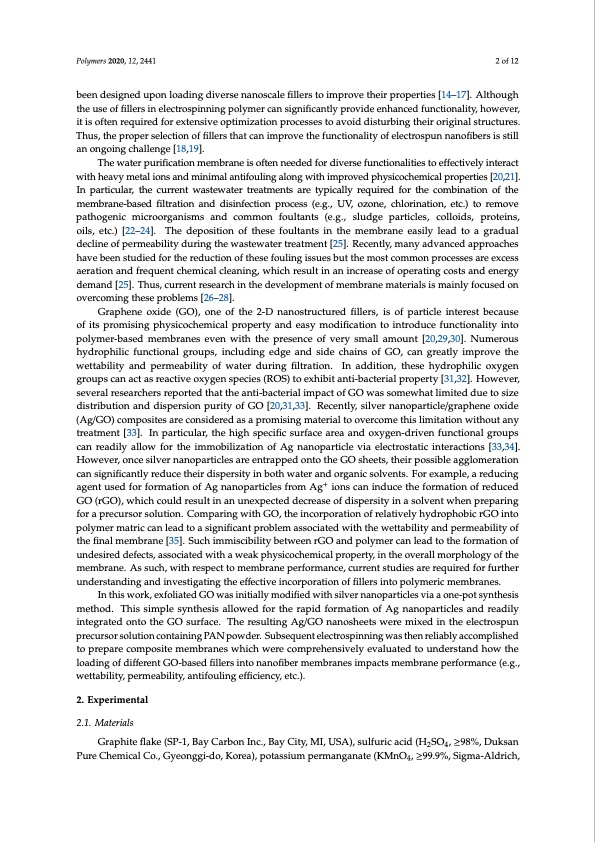
PDF Publication Title:
Text from PDF Page: 002
Polymers 2020, 12, 2441 2 of 12 been designed upon loading diverse nanoscale fillers to improve their properties [14–17]. Although the use of fillers in electrospinning polymer can significantly provide enhanced functionality, however, it is often required for extensive optimization processes to avoid disturbing their original structures. Thus, the proper selection of fillers that can improve the functionality of electrospun nanofibers is still an ongoing challenge [18,19]. The water purification membrane is often needed for diverse functionalities to effectively interact with heavy metal ions and minimal antifouling along with improved physicochemical properties [20,21]. In particular, the current wastewater treatments are typically required for the combination of the membrane-based filtration and disinfection process (e.g., UV, ozone, chlorination, etc.) to remove pathogenic microorganisms and common foultants (e.g., sludge particles, colloids, proteins, oils, etc.) [22–24]. The deposition of these foultants in the membrane easily lead to a gradual decline of permeability during the wastewater treatment [25]. Recently, many advanced approaches have been studied for the reduction of these fouling issues but the most common processes are excess aeration and frequent chemical cleaning, which result in an increase of operating costs and energy demand [25]. Thus, current research in the development of membrane materials is mainly focused on overcoming these problems [26–28]. Graphene oxide (GO), one of the 2-D nanostructured fillers, is of particle interest because of its promising physicochemical property and easy modification to introduce functionality into polymer-based membranes even with the presence of very small amount [20,29,30]. Numerous hydrophilic functional groups, including edge and side chains of GO, can greatly improve the wettability and permeability of water during filtration. In addition, these hydrophilic oxygen groups can act as reactive oxygen species (ROS) to exhibit anti-bacterial property [31,32]. However, several researchers reported that the anti-bacterial impact of GO was somewhat limited due to size distribution and dispersion purity of GO [20,31,33]. Recently, silver nanoparticle/graphene oxide (Ag/GO) composites are considered as a promising material to overcome this limitation without any treatment [33]. In particular, the high specific surface area and oxygen-driven functional groups can readily allow for the immobilization of Ag nanoparticle via electrostatic interactions [33,34]. However, once silver nanoparticles are entrapped onto the GO sheets, their possible agglomeration can significantly reduce their dispersity in both water and organic solvents. For example, a reducing agent used for formation of Ag nanoparticles from Ag+ ions can induce the formation of reduced GO (rGO), which could result in an unexpected decrease of dispersity in a solvent when preparing for a precursor solution. Comparing with GO, the incorporation of relatively hydrophobic rGO into polymer matric can lead to a significant problem associated with the wettability and permeability of the final membrane [35]. Such immiscibility between rGO and polymer can lead to the formation of undesired defects, associated with a weak physicochemical property, in the overall morphology of the membrane. As such, with respect to membrane performance, current studies are required for further understanding and investigating the effective incorporation of fillers into polymeric membranes. In this work, exfoliated GO was initially modified with silver nanoparticles via a one-pot synthesis method. This simple synthesis allowed for the rapid formation of Ag nanoparticles and readily integrated onto the GO surface. The resulting Ag/GO nanosheets were mixed in the electrospun precursor solution containing PAN powder. Subsequent electrospinning was then reliably accomplished to prepare composite membranes which were comprehensively evaluated to understand how the loading of different GO-based fillers into nanofiber membranes impacts membrane performance (e.g., wettability, permeability, antifouling efficiency, etc.). 2. Experimental 2.1. Materials Graphite flake (SP-1, Bay Carbon Inc., Bay City, MI, USA), sulfuric acid (H2SO4, ≥98%, Duksan Pure Chemical Co., Gyeonggi-do, Korea), potassium permanganate (KMnO4, ≥99.9%, Sigma-Aldrich,PDF Image | Polyacrylonitrile Nanofiber Membrane Water Purification

PDF Search Title:
Polyacrylonitrile Nanofiber Membrane Water PurificationOriginal File Name Searched:
polymers-12-02441.pdfDIY PDF Search: Google It | Yahoo | Bing
Turbine and System Plans CAD CAM: Special for this month, any plans are $10,000 for complete Cad/Cam blueprints. License is for one build. Try before you buy a production license. More Info
Waste Heat Power Technology: Organic Rankine Cycle uses waste heat to make electricity, shaft horsepower and cooling. More Info
All Turbine and System Products: Infinity Turbine ORD systems, turbine generator sets, build plans and more to use your waste heat from 30C to 100C. More Info
CO2 Phase Change Demonstrator: CO2 goes supercritical at 30 C. This is a experimental platform which you can use to demonstrate phase change with low heat. Includes integration area for small CO2 turbine, static generator, and more. This can also be used for a GTL Gas to Liquids experimental platform. More Info
Introducing the Infinity Turbine Products Infinity Turbine develops and builds systems for making power from waste heat. It also is working on innovative strategies for storing, making, and deploying energy. More Info
Need Strategy? Use our Consulting and analyst services Infinity Turbine LLC is pleased to announce its consulting and analyst services. We have worked in the renewable energy industry as a researcher, developing sales and markets, along with may inventions and innovations. More Info
Made in USA with Global Energy Millennial Web Engine These pages were made with the Global Energy Web PDF Engine using Filemaker (Claris) software.
Infinity Turbine Developing Spinning Disc Reactor SDR or Spinning Disc Reactors reduce processing time for liquid production of Silver Nanoparticles.
| CONTACT TEL: 608-238-6001 Email: greg@infinityturbine.com | RSS | AMP |